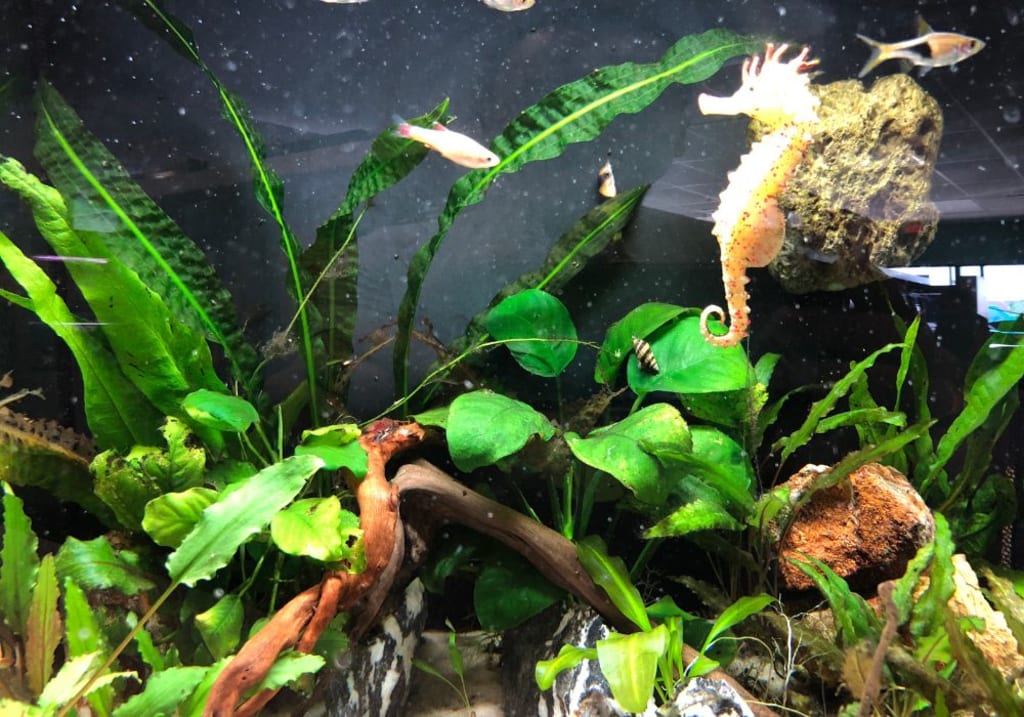How to Keep Algae Out of Your Fish Tank
A Comprehensive Guide

Introduction to Algae in a Fish Tank: What is it, and What are the Benefits and Drawbacks?
Algae is an aquatic plant that can be found in fish tanks. It is a natural component of any healthy aquatic ecosystem, but it can also become an issue if it takes over the tank. In some cases, algae can provide additional food sources for fish, while in others it can cause problems with water clarity and oxygen levels. It is important to understand how to keep algae out of your fish tank as part of a comprehensive maintenance plan. This guide will help you understand the basics of algae control as well as provide tips on how to reduce its presence in your tank.
What Causes Algae Growth?
Algae growth is usually caused by too much light or nutrient-rich conditions in the fish tank. Too much sunlight will activate the photosynthesis process that causes most algae species to grow rapidly. An accumulation of organic matter such as uneaten food, fish waste, or decaying plant matter can also increase nutrient levels which result in an abundance of microalgae in the tank. Poor filtration or circulation can also result in high levels of algae growth.
How Can You Prevent Algae Growth?
The simplest way to prevent excessive algae growth is by decreasing light exposure and nutrient levels within the tank. This includes avoiding bright lighting fixtures for long periods each day and providing regular water changes with fresh dechlorinated water. Additionally, proper filtration should be installed on tanks with heavier bioloads (such as those with more than one fish), as this will help ensure that organic matter does not accumulate excessively.
What Are Some Other Methods for Controlling Algae Growth?
There are many other methods for controlling excessive algae growth, including using chemical treatments like algaecides or using natural predators such as snails or certain species of shrimp. If you opt to use chemicals make sure to research them carefully before making any purchases. Natural predators should also be added gradually and only if they are compatible with existing species of fish.
Conclusion
Algae can be beneficial for your aquarium when managed correctly; however, its presence should always be kept under control. To help minimize excessive algae growth, take steps such as reducing light exposure or adding natural predators like snails or shrimps into your aquarium environment. Additionally, make sure that proper filtration systems are installed on tanks with heavier bioloads, and perform regular water changes with fresh dechlorinated water.
Understanding the Causes of Algae Growth in a Fish Tank
Algae are one of the most common inhabitants of any fish tank, and while they can play a beneficial role in the aquarium's ecosystem, too much algae can be an unsightly problem. To ensure your tank remains healthy and free from excess algae, it is important to understand what causes algae growth and how it can be prevented.
The most common cause of algae growth in a fish tank is too much light. Algae need sunlight to grow, so any excess lighting in your tank will encourage its growth. In addition to this, if you have live plants in your aquarium they will use the light for photosynthesis which will reduce the amount available for algae growth.
Nutrients are another major cause of algae growth. Unfiltered tap water that contains high levels of nitrogen and phosphorus can quickly become overrun with algae, as these nutrients act as fertilizer for its growth. Overfeeding your fish or leaving uneaten food in the tank can also contribute significantly to excessive nutrient levels which will encourage algae blooms.
Finally, warm temperatures are also favorable for some types of algae growth. If your tank is particularly warm it may be more prone to an algae outbreak that could affect both water quality and clarity.
Identifying and eliminating these factors is essential if you want to keep excessive amounts of algae out of your fish tank. Reducing lighting, using filtered tap water, feeding sparingly and controlling temperature will all help to keep your aquarium free from excess algal blooms while still allowing beneficial species to flourish.
Strategies for Keeping Algae Out of Your Fish Tank: Cleaning, Lighting, Filtration, and More
Keeping algae out of a fish tank can be a tricky task. To ensure your tank remains free from the pesky plant life, it is important to take care of the environment you are creating for your fish. Fortunately, there are several strategies that can help you reduce algae in a fish tank. These include cleaning the tank regularly, adjusting lighting levels, using effective filtration systems, and more.
Cleaning
One of the simplest yet most important ways to keep algae out of your fish tank is to clean it regularly. You should also vacuum gravel on a regular basis to remove any uneaten food or decaying matter that could lead to an excess of nutrients in the water that can feed algae growth. Additionally, you should replace 10-20% of the water at least once a month in order to maintain good water quality.
Lighting
The amount and type of light you provide for your tank can also affect algae growth. Opt for lights that provide moderate brightness throughout the day rather than intense light that will promote photosynthesis and cause excessive plant growth in your tank. Fluorescent bulbs tend to work better than incandescent bulbs as they emit less heat and fewer harmful UV rays which can encourage algae growth. Additionally, use timer switches so you’re not over-lighting your tank; aim for around 8 hours per day rather than 12-14 hours per day which is more likely to cause rapid plant growth in the aquarium.
Filtration
An effective filtration system is essential in keeping algae away from your fish tank since it helps remove the accumulated organic waste that leads to an excess of nutrients in the water which contributes to healthy plant growth. Look for filters with media bags or cartridges that contain activated carbon; these are great choice as they absorb organic particles like dust, dirt and bacteria which will help reduce potential algal blooms. Additionally, make sure you keep up with filter maintenance; this includes replacing old filter media or cleaning filter components regularly as this helps prevent build-up of organic waste matter that could lead to an increase in nutrient levels and therefore an increase in possible algal blooms within the aquarium environment.
Nutrients
Pay attention to how much food you’re feeding your fish; overfeeding is one of the major causes leading to sudden algal blooms since it adds extra nutrients into the aquarium environment which encourages plant growth along with other living organisms like bacteria and fungi cells. Therefore, only feed what your fish can consume within a few minutes as any extra food will sink down into gravel bed where microbes start breaking it down and releasing those same nutrients into water column promoting algal bloom formation over time if not managed properly via regular filter maintenance and partial water changes each week or two weeks at max depending on size/type/bioloads of fishes kept inside aquarium environment itself . By following these simple tips – such as consistently cleaning your tank, moderating lighting levels, using effective filtration systems and monitoring nutrient intake – you can keep pesky algae out of your fish tank!
Conclusion: Steps to Take for a Healthy Fish Tank Environment Free of Algae
By following the steps outlined in this comprehensive guide, you can reduce algae in your fish tank and maintain a healthy and sustainable environment for your fish. The key to preventing algae is to create balance in the tank. Without balance, light and nutrients will encourage the growth of algae. It's important that you monitor the water parameters of your tank regularly, test ammonia, nitrate, and nitrite levels often, and adjust accordingly. Aquarium maintenance is essential as it helps remove debris and uneaten food that would otherwise break down and contribute to nutrient overload. Additionally, be sure to keep the tank clean by removing dead plant material or other decomposing organic matter. Lastly, control light exposure by limiting the amount of time lights are on during the day – no more than 10-12 hours per day – as well as controlling light intensity by reducing wattage or using a timer.
The most important step in keeping algae out of your fish tank is managing light exposure. Too much light can cause excess algae growth. Therefore, limit exposure by keeping lights off for extended periods during the day (no more than 10-12 hours) and reducing wattage or using a timer for controlled lighting. Regular aquarium maintenance is also essential for keeping your fish tank clear of excessive algae build up, as it helps remove debris and uneaten food that would otherwise break down into nutrients which can contribute to nutrient overload. Lastly, it is important that you monitor water parameters regularly to ensure a balanced environment free from excess nutrients which could lead to an overgrowth of algae. By following these steps you can create a healthy and sustainable environment for your fish while simultaneously preventing excessive algae growth.
About the Creator
Hasan
Welcome...
In this site of mine you can learn amazing things and many information that you don't know so please subscribe to my site.
Enjoyed the story? Support the Creator.
Subscribe for free to receive all their stories in your feed. You could also pledge your support or give them a one-off tip, letting them know you appreciate their work.






Comments
There are no comments for this story
Be the first to respond and start the conversation.